Did you knowwhat 96% of your website visitors are not yet ready to buy anything on their first visit !? This statistic illustrates whyit is so difficult to make sales with a website, even if you have everything set up to generate a lot of traffic.
Afterwards, as I had the opportunity to say, visitors are not“still not ready”, ce which implies that they are likely to change their mind and make purchases from you later. Forincrease your chances of conversion, marketing specialists have designed several tools, one of the most effective of which isthe sales funnel.
This powerful instrument not only allows you togenerate significantly more sales or conversions when you use it correctly, but alsocreate a community of loyal customers.
In this article, we will take the time to see what a sales funnel is, why it is important to have one, how to build a profitable sales funnel and optimize it.
All about conversion funnels
In this video, I explain the main principles around the sales funnel :
Find my presentation on sales funnels :
Lead nurturing: The secret to sales!
Generating traffic or leads on your website isa method that often proves ineffective. Then comes l’conversion optimization of an online business, goes beyond the layout of its website, the design of forms, the implementation of irresistible offers, etc…In fact, your customers are not machines,they are real people and prefer to be treated that way. For this reason,jI invite you to consider your strategy,a temporality of conversion of a customer which will materialize by the maturation de prospects ou le leads nurturing.
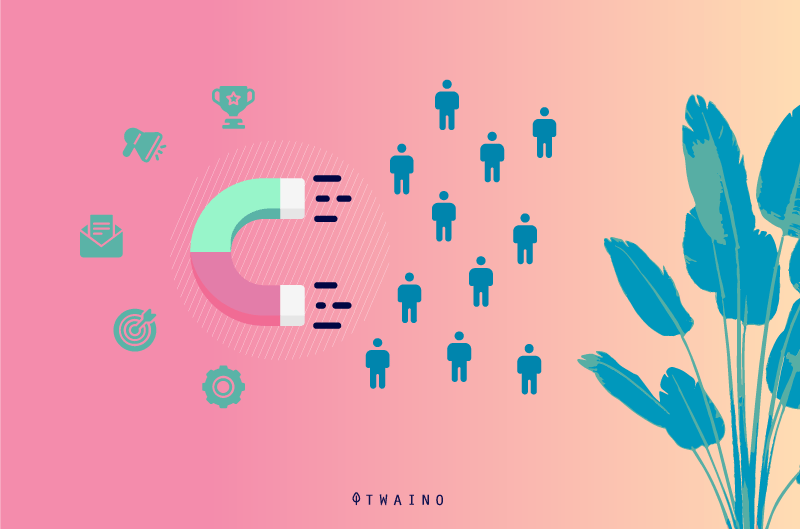
As we saw at the beginning of the introduction, most prospects are not ready to make a purchase during their first visit.
Indeed, when visitors come to see your offer for the first time, they adopt a position ofdistrust, which manifests itself in a refusal but which is necessarily not firm.
You cantranslate this attitude like a “No, not now » rather than a “No never » categorically.This change in perspective will allow you to think about strategies to try to convert this refusal into a positive response.
Indeed, companies that take care of cultivate their leads see an increase in the number of qualified prospects by 450%.
And it is far from over, those who ensure maintain and develop relationships with customers see their sales increase by 50% at a lower cost of 33%.
Better, with a good maturation process, 15 to 20% of the 96%, who were not ready to purchase, become customers and generally carry out 47% larger purchases than unsupported ones.
In summary, theProspects reward you if they feel that you care about their needs and, above all, that you anticipate them.
At this stage, the real question is: How can we anticipate what the potential customer wants and deliver it to them before they ask for it? The answer is quite simple:A sales funnel.
The sales funnel: a powerful marketing tool
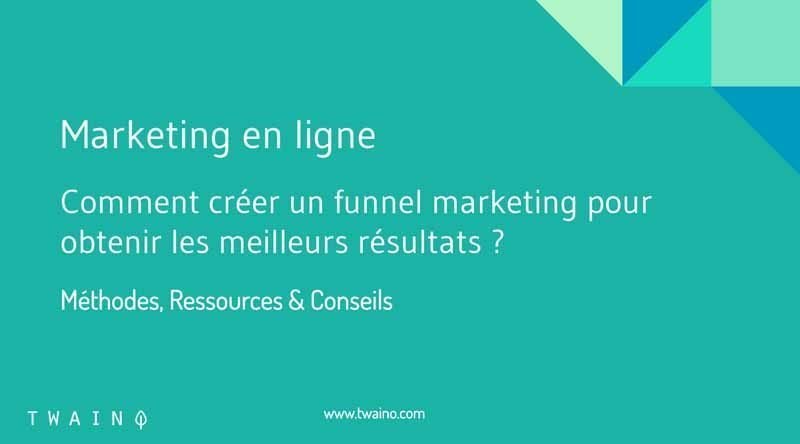
Definition of the sales funnel
The concept ofsales funnel, conversion funnel or even sales tunnel simply refers tothe path a lead takes to your website and ends in a conversion or purchase.
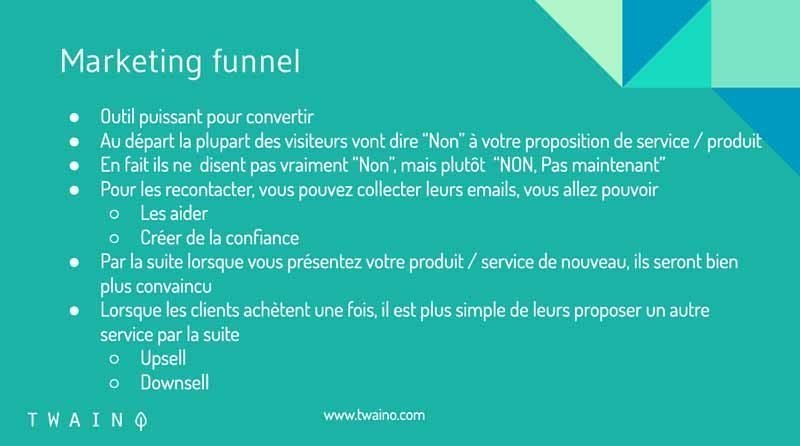
In other words, the sales funnel allows you to break down the customer journey, from the first contact with your brand to purchase and loyalty.
To illustrate this journey, let’s take the example of a visitor who arrives on your website through a Google search. At this stage, it is one of your visitors who will take the time to browse your list of products or your blog posts.
During navigation, you set up an email collection system that he uses to register. By completing this form, the visitor becomes a prospect to whom you can promote your products or services outside of your website.
The latter will tend to return to your website if you send them special offers or information that they find irresistible.
Once trust is established with your content and decision-making, this prospect becomes your customer by making one or more purchases.
These are the key stages of this journey that the sales funnel allows to analyze and optimize. Besides, how could you optimize a process if you don’t know how it works?
Furthermore, this term funnel is nothing more than a schematization of the fact that although you have a large number of visitors, those who actually convert are generally fewer.
Prospects that don’t convert!
The fact that there are leads that do not convert may be due to several factors such as:
- Your website that does not inspire confidence : In addition to convincing visitors of the quality of your services, you must also show the seriousness of your company. Remember to have a good design, pages such as “Legal notices”, “General conditions of sale”, “Who are we? »…
- Your content is low quality : Bring relevant information to your audience so they can find everything they want right on your website, and a blog can be a great help in doing this.
- Your offerings and added value are unclear : Be clear and precise enough about the benefits and reasons why your visitors should use your services.
- You have a method for collecting prospect data not very effective: Spontaneously giving contact details is not part of our habits. To do this, set up a good process to collect the emails or information you need.
- Etc…
These factors increase your bounce rate and in this condition, your conversion rate decreases. For this, the construction of aconversion tunnel will allow you to identify these “leaks” and repair them. That said, you should first know the process that customers follow when making their purchases.
The 5 main phases of the consumer purchasing process
We all follow a similar path when we want to make any purchase. In fact, it is John Dewey which introduced this purchasing process and which has served as a basis, since 1910, for the design of sales funnels.
Phase 1: Recognition of needs
In the purchasing process,the identification of the “need” in relation to a service or product is something you need to first cunderstand and highlight.
Indeed,upstream of the “needs” there is often a “problem” to be solved, such as for example a breakdown of your vehicle en route (the problem), which leads you to want to repair it (the need).
They can also be caused bydesiresWho generally manifestby an external stimulus, like an advertisement or by observing a person who enjoys the product. For example, you saw a colleague driving ina irresistible Mercedes (desire), you also decide to buy this same car or another car from the brand (need).
This emotional state of identifying a need is the one in which buyers will find themselves when purchasing your products or services. At your level, you must be able todetect the circumstances that trigger the need for your products among your target.
Consider gathering information about how stimuli spark interest. Based on this data, you can then develop marketing strategies to generate consumer interest at will.
Phase 2: Information search
Information search is the step that directly follows the recognition of a problem. This research can take several forms depending on the type of need:
- Search on Google;
- Request for recommendations from loved ones;
- Checking discount coupons;
- Reading online reviews;
- Visit to stores for practical demonstrations;
- Etc…
Among these options, searching on Google is the one that comes up most often, especially since 70% of buyers turn to Google at least two to three times during their search. And this to find out more about their problems, the solutions to consider and the companies to turn to.
At this stage,the consumer is looking for tactical information that he could use to solve his problem. In this measurement,you can offer informative content which will aim to help people who need it as much as possible.
This action lets your visitors know exactly what they need to solve their problems or desires. To do this, it is relevant to carry out research on keywords related to your activity in order to know the types of content to create.
At this stage, it would be necessaryidentify the sources used by consumers and the value of each of them. On this basis, you will be able to develop an effective communication strategy.
Phase 3: Evaluation of alternative solutions
This step is sometimes intertwined with the previous one, but we will consider here that it simply follows the search for information. In fact, the length of time this evaluation takes varies depending on the type of purchase the consumer is about to make.
For example, choosing a restaurant can sometimes be as simple as choosing between an Italian or Chinese restaurant.
On the other hand, if you were to treat yourself to a new car, the evaluation process is likely to be much longer since an acquisition requires a significant investment.
You may go to different dealerships to do several free trials and see the offers that accompany each product. Which will obviously take more time than choosing a restaurant.
Furthermore, the criteria that are often taken into account for the evaluation stage are, among others:
- Qualities, characteristics or attributes and performance of the product;
- Price variation depending on the brand;
- History of brands;
- Popularity, image or reputation of brands;
- Services related to the products offered by the brands, such as after-sales service, warranty and free installation;
- Availability of brands and dealer ratings;
- Etc…
In terms of our previous example of purchasing a vehicle, we can distinguish criteria such as:
- The price ;
- Performances ;
- Equipment and comfort;
- The design and appearance;
- Speed per hour;
- The average per liter of gasoline;
- Maintenance costs;
- The image, statue and novelty;
- Security ;
- Special offer, guarantees,
- Etc…
The consumer is likely to prefer the brand that adequately meets their evaluation criteria. For this you must take care ofhighlight the points that differentiate youthe most of the rest of the market. For example, you can make a comparison table to help consumers evaluate different brands.
Phase 4: Purchase decision
After identifying the problem, evaluate the different alternatives and choose the best option, buying is nothing but the natural conclusion. This is the stage where theconsumer chooses the brand that he believes offers the most satisfaction and benefits. Thus, the decision to actually make a purchase is made, but certain factors can influence this intention.
The first factor is the attitude of other customers and the consumer’s motivation to accept this attitude. Indeed, purchasing intention can be impacted if other customers have a negative attitude towards the brand or product chosen by the consumer.
For example, you want to buy a car that seems to be perfect for you, but you notice that there are reviews on several websites.negative on the car of your choice.
You can decide to no longer make the purchase.That said, always start from principle that all comments on the internet should be taken with a grain of salt.
The second factor is linked to unforeseen situations such as:
- The sudden increase in price;
- Diseases ;
- Accidents ;
- Loss of employment;
- Unavailability of the product;
- Etc…
In these conditions, it is wise tocreate content that will allow you to persuade your audiencewhether your product or service will work in their respective situation.
Perhaps you can do case studies of certain customers that reflect different demographics of your ideal customers.
Phase 5: Post-purchase behavior
The purchasing process goes beyond decision-making. In other words, the step that comes after the sale is as important as those that allowed the consumer to make the decision to buy.
The consumerbuy it product with certain expectations, even if it recognizes in advance that there is no guarantee of total satisfaction. Indeed, there is generally a variation between the expected level of satisfaction and actual satisfaction after the acquisition.
In this sense, the customer can be satisfied or dissatisfied, whichcan have a big influenceon the decision-making process for similar purchases from the samebrandin the future.
In case your customer is satisfied, this can translate into loyalty to your brand. Therefore, future searches for information and evaluation of alternatives will often be accelerated or completely ignored for your benefit.
On the other hand, when the customer is disappointed or dissatisfied, he may request refunds or engage in counter-advertising.
Note, however, that based on their dissatisfaction or satisfaction, consumers tend to give their positive or negative comments on the product or service.
They can go through reviews on websites including yours if you add the option, social networks or even word of mouth.
Therefore, you must beattentive to the creation of effective communication after the purchase of your customers in order to retain them.
Remember that at this stage, your greatest strength is your product which must be of very good quality to resolve possible problems on its own.
Additionally, you can implement help desk or content that will improve consumer behavior post-purchase. These are for example:
- Demonstration videos;
- Frequently asked questions;
- Etc…
Finally, be aware that some consumers may not enter your sales funnel from the top and enter at other stages.
This generally depends on their level of information, but the process remains the same regardless of the stage at which a consumer enters the sales funnel.
Understand the stages of a sales funnel
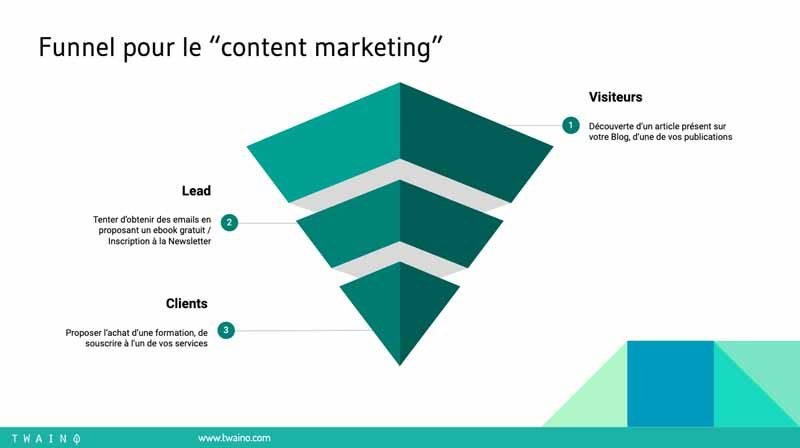
You now know how the purchasing decision is made by consumers and you can use this information to establish an effective sales strategy. This will be represented by the traditional or digital sales funnel.
The traditional sales funnel
Basically, the sales funnel is made up of four stages which are also known by the acronym, formulated in 1898 by E. St. Elmo Lewis, A.I.D.A :
- Awareness : Attention
- Interest : Interest
- Decision: Decision
- Action : Action
They are directly linked to the consumer purchasing process andeach of them requires a different approach from you, since we should not send the wrong message at the wrong time.
Take the example of a waiter who asks you what you would like for dessert, when you haven’t even ordered the starters and drinks yet, that obviously wouldn’t make sense. So what do these four different steps involve?
Step 1: Attract Attention
This is the moment when you first catch the attention of a consumer through, for example:
- A Google search;
- To a tweet;
- Has a post on Facebook;
- To a social media post shared by a friend;
- Etc…
At this stage, theconsumer becomes aware of the existence of your company and what it offers.
Sometimes some consumers make a purchase straight away and in this case it’s usually because they have already done some research and see that your product and its cost is right for them.
You can consider this first step as a “seduction” phase since you will try toconvince him to come back to your website and to involve you in some way in their purchasing process.
To do this, you can create content that describes the problems that arise from the problem and how your product solves it.
You can also develop content that indicates the attributes of your products and that is likely to encourage the prospect to include you in their future evaluation. Besides, don’t forget to present your business in order to increase your credibility.
Step 2: Generate Interest
At this stage, consumers carry out research, make reviews or comparisons and consider the ideal option to choose.
This is the ideal stage to create content that actually helps them without trying to sell them the product.
The idea at this stage is toestablish your expertise with the aim of helping, as much as possible, the consumer to make an informed choice.
To do this, you can create a product comparison table that clearly shows the strengths of your product or service compared to those on the market. Also do case studies of some customers who have had success with your product.
Step 3: Provoke the decision
At this stage, the customer has finally chosen two or three options and is ready to make their purchase. This is the perfect time to make your best offer, it could be:
- One more product;
- A promotional code;
- Of a gift;
- Free delivery;
- Etc…
Take care to return your offer so irresistible that the consumer is eager to take advantage of it.
Step 4: Encourage Action
This is the last level of your funnel and this is when the consumer buys your product or service and becomes part of your brand’s environment. However, don’t consider your job done with this purchase.
In fact, the idea at this stage is toclient faithfulness in order to transform this single purchase into 5, 10 or even 100… To do this, think about:
- Express your gratitude for the purchase made;
- Invite him to share his criticisms;
- Provide technical support;
- Etc…
Digital conversion funnels
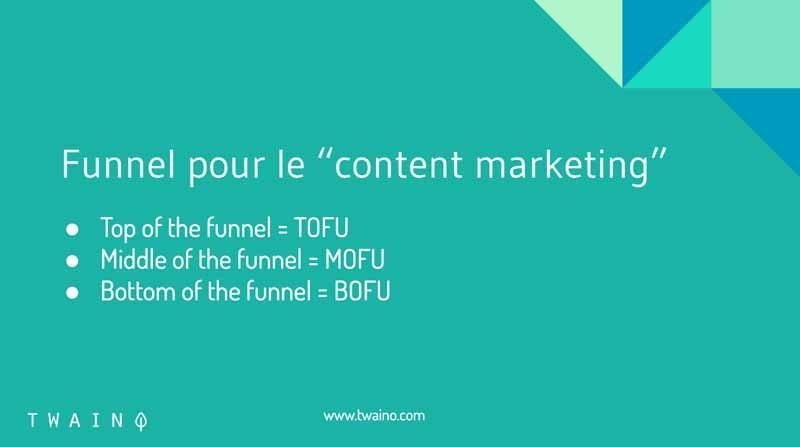
Establishing a digital conversion funnel allows you to identify the different entry points on a web page in order to lead your visitors to gradually move towards a purchase.
This process is broken down into three different parts which join the previous four:
- Top of the funnel or TOFU (Top Of funnel)
- Middle Of Funnel or MOFU (Middle Of Funnel)
- Fond du funnel ou BOFU (Bottom Of funnel)
1) Top of the funnel or TOFU
The top of the funnel is also known as TOFU or Top of the funnel. This is the entry point where most of your visitors first become aware of the existence of your online brand.
This step therefore corresponds to that of “Attract attention” on your site and your brandIt is.
Therefore,this phase also does not aim to directly make sales, but to ensure that Internet users can first land on your website. This could be a landing page or your home page.
Then, you use content to address the consumer’s problem or need with support from your product or service that addresses the problem in question.
Additionally, consider putting systems in place to collect information about them, including their email address.
2) Middle of the funnel or MOFU
People who get to this stage are generally more invested, familiar with your brand, and wondering if you have anything of value to offer. To this extent, they are considering whether to leave or engage with you.
This stage is similar to the “Arouse interest” stage and means that you must focus your efforts on creating quality content, targeted offers and follow-up campaigns.
This is the moment when trust with the visitor is created, and the ideal situation to obtain the latter’s email in exchange for a newsletter or an ebook. The objective at this level is tostrengthen the relationship so that the lead moves to the final stage : BLIND.
3) Bottom of the funnel or BOFU
Also called Bottom of the funnel, BOFU is the final stage of your sales funnel and leads to consumer decision-making. It depends on the strategies you used at the TOFU and MOFU level, as well as the consumer purchasing behavior.
This stage brings together the actions of the two stages “Provoke the Decision” and “Incite Action”. Therefore, reminders, retargeting, and incentive offers work best here.
But after the customer purchases your product, it is necessary manage your customer experience in order to retain them and if possible transform them into ambassadors.
A Simple Example of an Effective Sales Funnel
Let’s say you have an e-commerce business where you sell men’s and women’s clothing. You havedefined your target as men and women aged 18 to 40 and you know that a large partis a heavy user of social networks, notably Facebook.
To do this, you launch an advertising campaign on Facebook which allows you to generate traffic to yourlanding page or your landing page.
On it, your prospects are invited to register in your mailing list in exchange for alead magnet.
Over the next few days, you take care to send content to educate your leads by addressing points such as:
- New trends;
- Tips for choosing the ideal size of your clothes;
- The looks of the season;
- Types of clothing depending on the events;
- Etc…
At the end of this first email campaign, you offer adiscount coupon 15% off your first order, which helps you generate lots of sales.
It’s not over, youadd these customers to another list broadcast by changing the content you are going to send them this time.
To this extent, you can send them content including information such as:
- Tips for taking good care of their clothes;
- How to renew your wardrobe;
- Etc…
In addition to giving them these ideas, you can give them gifts, which helps ensure they come back to shop again.
In summary, we have:
- TOFU : You created a Facebook ad to drive people to your website;
- THE DEAD : You offer something of value in exchange for their email address and your content informs your audience and prepares them for a purchase;
- BLIND : You offer a coupon that your prospects cannot resist, And you stimulate their loyalty.
Several tools can help you optimize this entire process, so we’re going to take a closer look at how to create a sales funnel.
Creating a profitable conversion funnel from scratch
For your funnel to easily move visitors from TOFU to BOFU, you need to have a good strategy. To do this, I present five main steps that will allow you to create a profitable conversion funnel.
Step One: Create landing pages or landing pages for lead capture
The top of your funnel or the TOFU represents in some way the basis of your strategy and this is where you will begin its creation. In addition, you must keep in mind that this level is entirely devoted to traffic and so that it can allow you to have leads,a landing or capture page is required.Indeed, a landing page can simply be your home page and could in this case look like this :
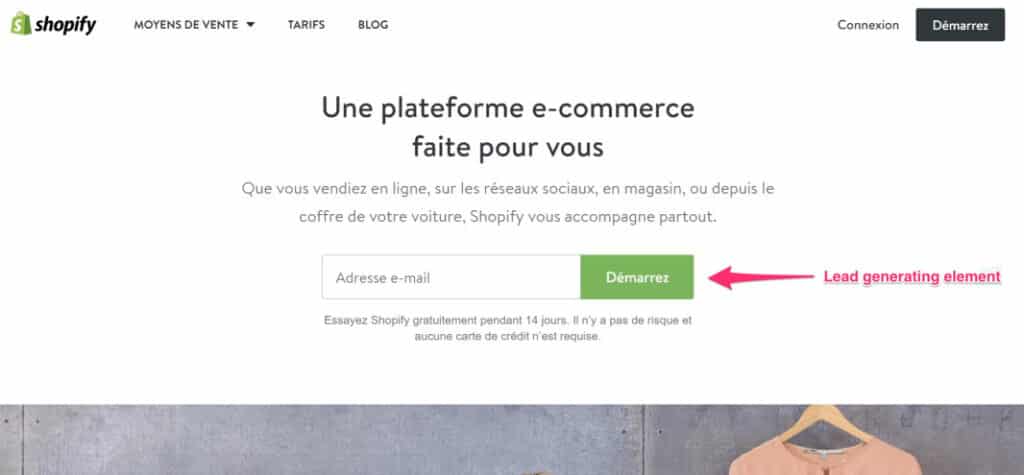
This home page includesa lead generator which allows you to collect visitors’ emails. You can also have a landing page that can generate leads like this one.
On this page, several elements allow Grasshopper to generate leads. You can also do the same by using call-to-action (CTA) buttons with quality content.
The idea is to provide relevant information and a demonstration or test to curious visitors.
Furthermore, you can set up landing pages that will reach visitors regardless of their level in the funnel.
Indeed, the Grasshopper page can reach a person who has just entered the funnel as well as a person who is at the MOFU and who would like, for example, to have a little more information on the product.
Take for example my homepage Twaino.com
The main text of the home page allows me to capture at the top of the funnel and the “Audi Free” CTA is a lead generator that helps me already capture emails from my visitors.
In addition, the navigation menu and the two CTAs “BLOG” and “SERVICES” allow those who are the most curious to have direct access to the most important pages and therefore to access the MOFU.The same goes for the HubSpot homepage :
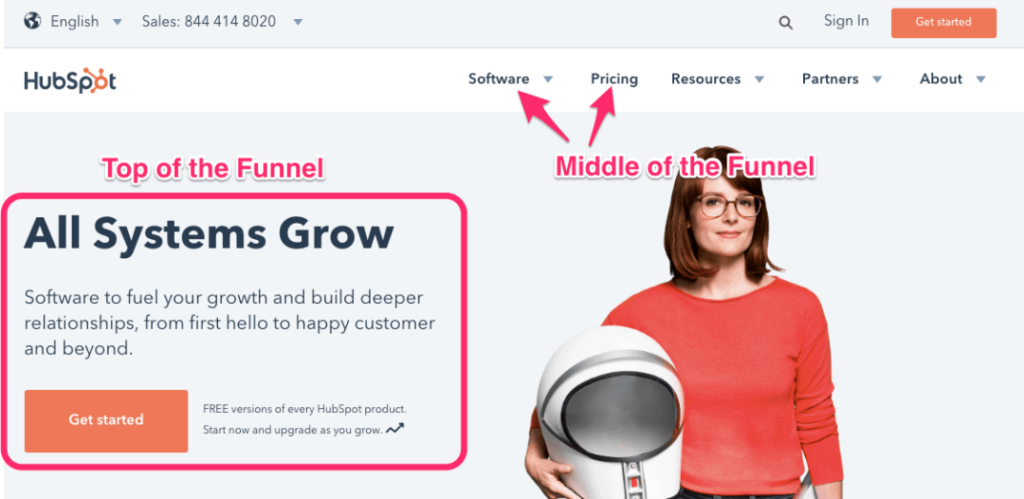
At this level, there is also a main message to capture at the top of the funnel and the navigation menu which gives access to the most important pages. When looking at their pricing page, you will see that all the content is aimed at those in the MOFU stage as well as those in the BOFU stage with the “Talk to Sales” CTA :
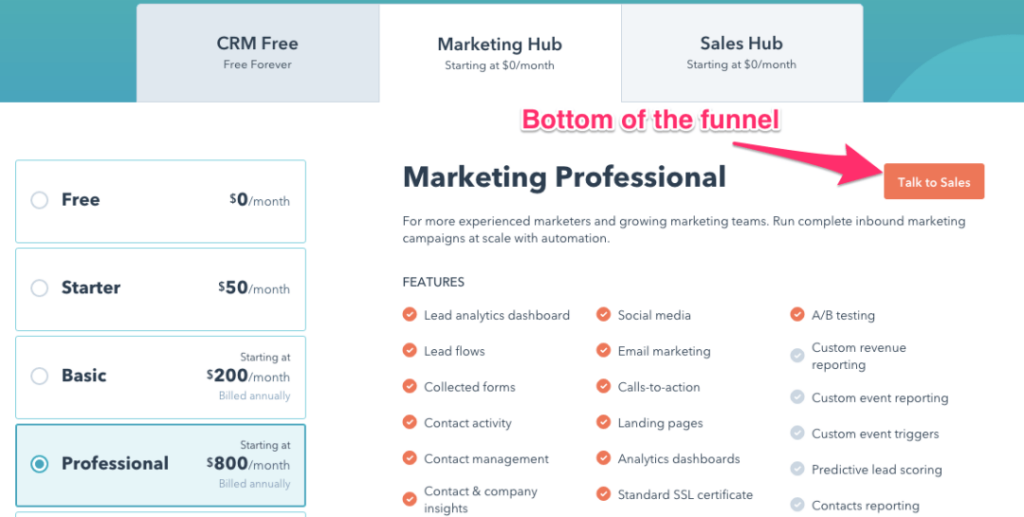
It therefore becomes obvious thatthe landing page is a very important factor that can influence the profitability of your sales funnel. Therefore, this is the first thing you should think about putting in place in order to drive buyers through all the stages of the process, a single landing page might not be enough.
Step Two: Drive Traffic to Your Landing Pages
According to a HubSpot study, generating traffic and leads is the main challenge for companies in terms of inboud marketing. Indeed, without traffic, even the best landing page in the world will not be able to generate sales for you.
To do this, you need to put in place a good strategy to effectively generate traffic to the landing pages you have set up and ensure that visitors reach BOFU.
To this extent, there are several methods that you can choose depending on your budget, audience and objective.
1) Generate traffic: Content marketing
Search engines drive 300% more traffic to content sites than social media. This proves that it would not be wise to rely only on social networks or advertisements. Moreover, 71% of B2B buyers say they consumed blog content during their buying process in 2018, and this, with an increase compared to 66% in 2017.
Without a doubt, adopting an effective content creation strategy will allow you to convert even more visitors. Indeed, thanks to its rich and detailed content,it is by far the ideal tool to influence consumers, especially at the MOFU level.
But to be effective, I invite you to be persistent in creating your content and this article may help you.
These three methods are the most used to generate traffic and by adopting a good strategy regarding each of them, you will attract a lot of visitors.
However, it is not enough to have visitors to hope to generate sales, remember that most prospects are not ready to make a purchase on their first visit. To do this, you need to put a process in place to bring them back.
2) Generate traffic: Pay per click (PPC) ads
Do you know that businesses earn an average of $2 in revenue for every dollar spent on AdWords in 2019 ?
This statistic shows that it would be interesting to take this option into account. Indeed, PPC advertising is still popular since it allows you to reach Internet users on several channels including social networks or search engines.
However, keep in mind that this option can sometimes be very expensive and it is wise toanalyze the return on investment before taking action.
In addition, it would be wise to accompany it with another method of generating traffic since there are more and more phones and computers that block these types of advertising. In 2017, the number of these electronic media that can block Ads has reached 142 million.
3) Generate traffic: Social media
In terms of your TOFU and MOFU, social networks are an excellent option for generating traffic to your landing pages. Indeed, 2019 social media statistics show that there are 3.2 billion social media users worldwide, and this number is only growing. Which currently equates to around 42% of the current population. Furthermore, we estimate at 2 hours 22 minutes, the average daily use time of social networks per person.
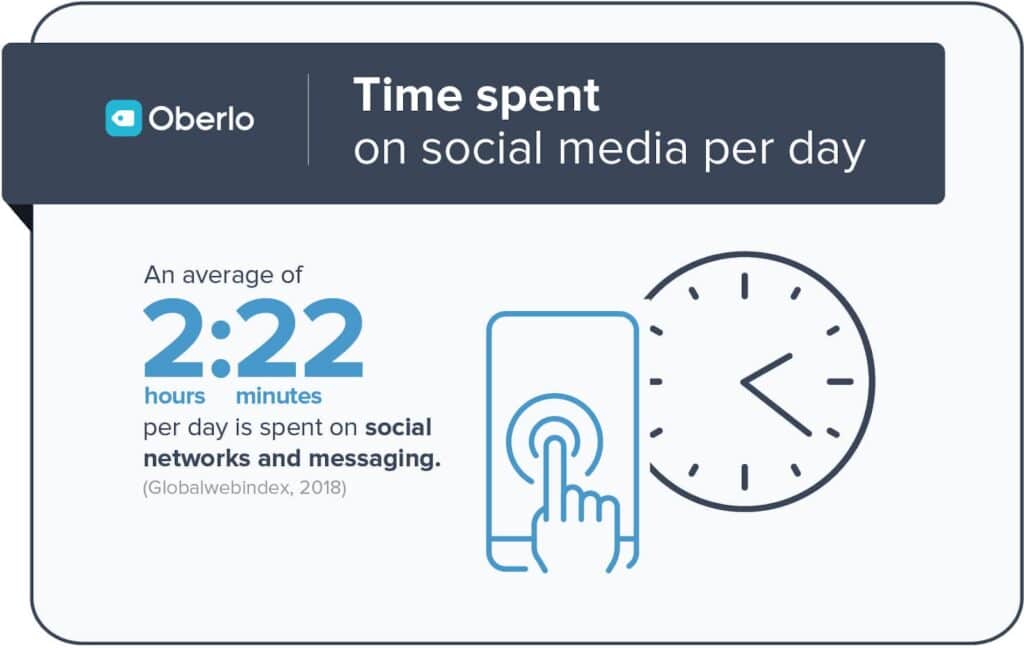
There is no doubt that this is an important lever in marketing, which is confirmed by 73% of marketers who believe their social media marketing efforts have been “somewhat effective” or “very effective” for their business.
Furthermore, this channel enormously influences customer choice since 48% of consumers are encouraged to make a purchase or conversion just by answering a customer’s question on social media.
Step Three: Collect Email Addresses
After implementing your strategy to attract traffic, you need to make sure you have content that captures attention. This will make your task of collecting emails from your visitors easier.
To achieve this effectively,find good lead magnets in order to provide something valuable to consumers in exchange for their email address. This address will be used to send them content that may lead them to make a purchase.
On this subject, I address the 9 unstoppable methods for collecting emails in one of my articles that I invite you to consult since it also includes valuable tips.
Step Four: Set Up an Email Marketing Campaign
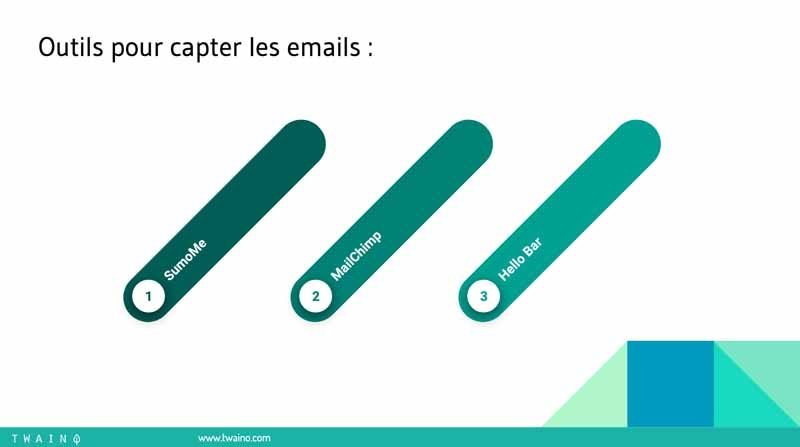
Once you have collected emails, the next action is to establish a relationship with your leads. To do this, you will use the precious weapon of collected emails.
According to statistics, the proportion of B2B marketers who use email marketing to generate leads is 87%. In addition, 31% of them believe that this type of marketing has the most influence on their income.
Furthermore, email is a channel that can be used to several objectives other than leading your prospects to the BOFU:
- Show that using your service is easy;
- Thank him ;
- Announce the launch of a new product/service;
- Promote new features;
- Send wishes;
- Promote new blog posts;
- Send personalized updates;
- Inspire your prospect;
- Show what you stand for;
- Etc…
At this stage, the idea is to remind your prospects that you still exist with a series of emails that tells them that you are ready to do business. However, you should definitely not harass them with a lot of messages since 78% of consumers unsubscribe because a brand sent too many emails. It is therefore important to respect a certain margin of time between each email sent.
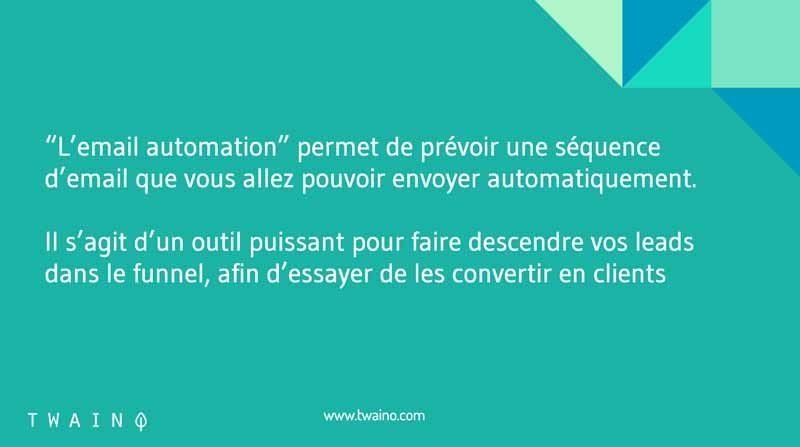
Without taking into account the time interval between two electronic messages, Neil Patel indicates that a typical campaign would look like this:
- Email 1 : You welcome prospects by thanking them for being interested in your products;
- Email 2 : This email may offer another important lead magnet such as an eBook, a valuable blog post, a trial version, etc.
- Email 3 : An email that presents a customer testimonial about your products;
- Email 4 : At this level you present stories that show how your products have helped Internet users without forgetting to mention how they can use your product or service.
- Email 5 : This last email will indicate the “forced sale” or the next step in your conversion funnel.
By designing such types of campaigns, you will allow prospects who do not yet know why they should use your services or products to be convinced and take action.
Several tools can allow you to automate the entire process so that you don’t have to send all those emails manually. These are for example:
- Drip : A powerful tool that is easy to use and pays for;
- Infusion Soft : A powerful tool that is a little complex to use and requires a fee;
MailChimp : A free tool up to a certain limit.
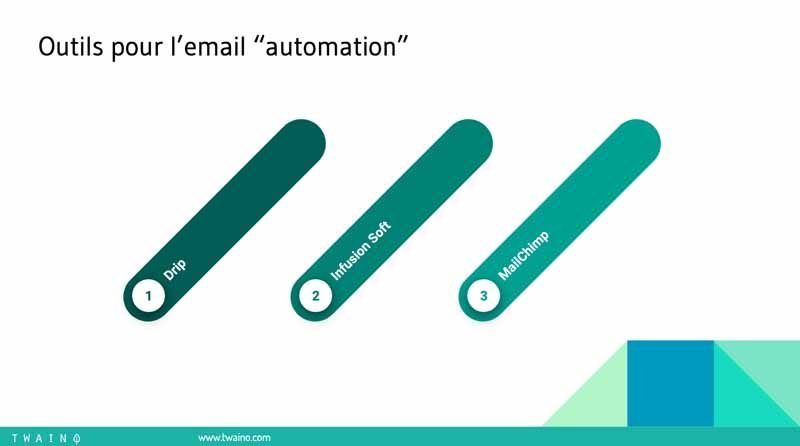
After implementing your email marketing strategy, you should now evaluate the success of your approach in order to make the necessary changes to refine the process.
Step Five: Monitor and optimize the conversion funnel
After creating your email campaign, you should already start generating sales if your sales funnel moves to the active phase.
However, monitoring each step will be very important to ensure that there are no leaks in your tunnel. In most cases, these holes are often found at the MOFU.
Indeed, if you cannot get traffic, get emails from your visitors or manage more sales, you will know that there is something wrong and the level at which the problem is located.
Therefore, you need to analyze your numbers and monitor your statistics to effectively track the success of your funnel.
Some tools can help you do this, for example:
- Customer relationship management or CRM software : It will allow you to track all new leads, offers you are offering and customers you currently have;
- Email tracking software : This concerns software such as Drip, MailChimp or Infusion Soft which can be integrated into your CRM;
- Social media tools : This is for example Buffer or Hootsuite which are of great use when you want to track the progress of your lead generation on these types of channels.
In case you do not have the proper tools such as a CRM to track the progress of your lead generation, you can use Google Analytics.
Indeed, it is a very powerful completely free tool that you can discover and install thanks to this article.
Additionally, you can configurer Google Analytics with your conversion funnel so that it can serve as an analysis tool, which will help you:
- Analyze the progress of the Internet user in your sales funnel;
- Know where visitors come from;
- Determine which landing pages generate the most leads;
- Measure the conversion rate.
This allows you to identify areas of your funnel that need to be improved and which could generate even more conversion.
To do this, it is useful to also adopt certain tips that will allow you to constantly optimize the performance of your funnel.
9 tips to adopt to optimize your marketing funnel
Tip 1: Keep it simple!
By setting up your sales funnel as part of your marketing strategy,make sure it goes straight to the point without unnecessarily distracting consumers. In addition, it must integrate perfectly into their navigation so that they do not feel disturbed.
To do this, in addition to favoring fluidity throughout the process, limit as much as possible the information you ask from your visitors as well as the choices you offer, a single CTA to move from one step to another for example. In short, focus on an optimal user experience.
Tip 2: Set targets correctly
For your strategy to work, you need to reach the right audience, otherwise you risk not making sales. To do this, take the time toclearly define the profit of your ideal customer.
For example, suppose you decide to sell ice cream and set up your storeAt Greenland, your business may not work since it is the second coldest country in the world. Conversely, if you target a country like Libya, your business has a greater chance of succeeding since it is the hottest country in the world.
Several elements can help you define or improve your targeting. These are for example:
- Polls or surveys;
- Statistics of your website using tools such as Google Analytics;
- Interactions with your customers;
- Data from your CRM tools;
- Etc…
Tip 3: Optimize SEO
Given that 93% of online experiences start with a search engine, it is very important to familiarize yourself with its powerful tools. What passes throughadoption of a good SEO strategy and for this, think about:
- An effective content creation strategy;
- To claim your file Google My Business ;
- To optimize the loading speed of your website;
- To return your site web responsive ;
- A installer Google Search Console in addition to Google Analytics;
- Etc…
In fact, SEO optimization is a major challenge and if using a professional is not yet one of your options, I invite you to do so. former to significantly improve your website traffic.
Tip 4: Use trigger marketing
This is a formidable practice that allows you toavoid losing prospects along your funnel.
Indeed, it is also known as trigger marketing and refers to the practices through which a marketing action is triggered automatically when an event occurs or in the case where a prospect undertakes a given action.
In other words, it is about automating your marketing actions so that automatically:
- A welcome email is sent to a new customer;
- A reminder email is sent after cart abandonment;
- A reminder email is sent to an inactive customer.
- Etc…
Astuce 5 : Le Down-selling, Up-Selling et Cross selling
These are three marketing techniques that can allow you togenerate even more sales. Indeed, cross selling allows you to increase the average basket by offering a product that complements the product that the customer is purchasing.
Let’s say the customer buys a laptop on your e-commerce site and you also sell protective cases for laptops.
If you can offer him an additional offer of a case in addition to his cell phone, there is a good chance that he will buy both products.
Down-selling, for its part, is used to offer another product with lower characteristics in place of the initial product.
Which is the opposite of Up selling which offers a product with superior characteristics. For example, in e-commerce we often find these types of articles in the section: “Customers who viewed this article also viewed”.
Tip 6: Personalize the customer relationship
To encourage customer loyalty,humanize your business by being sociable and available. With this in mind, social media is a great tool you can use.
You can also personalize the emails in your email campaign. Indeed, a survey indicates that emails have 22 % more chance of being opened if their object is personalized with the recipient’s first name.
This statistic is not very surprising since we generally prefer emails that are addressed to us personally than traditional emails.
Furthermore, you can also use chatbots or webinars which areformidable weapons that hinder purchasing.
Tip 7: Reassure the audience
Whatever type of business you have,trust is the #1 criterion that will drive visitors to BOFU.
To do this, it is important to implement a strategy that allows you to control Internet users’ distrust at all levels of your tunnel.
To do this, integrate content that shows your seriousness and professionalism, which will allow your visitors to be reassured.
Therefore use elements such as:
- Easy-to-identify contact details;
- Des labels ;
- Customer reviews;
- A website and quality content;
- Etc…
Tip 8: Offer really advantageous offers
In order to encourage visitors to your site to buy your product or service, it is important to make irresistible offers. Consider offering free trials or freebies to attract them and offering discount coupons or free shipping to keep them loyal.
Tip 9: Create impactful calls-to-action
Your conversion funnel is a sort of chain and you must ensure that the Calls To Action that will lead consumers to the next step are irresistible. To do this, take care to work on its design and choose the most impactful expressions.
This Neil Patel resource, will allow you to set up an irresistible CTA.
Tip 10: Constantly optimize funnels
A sales funnel is far from being a static tool; it must be constantly refined in order tocontinually optimize its performance. To do this, constantly monitor your statistics to detect leaks and also test several strategies to choose the one that works best.
Conclusion
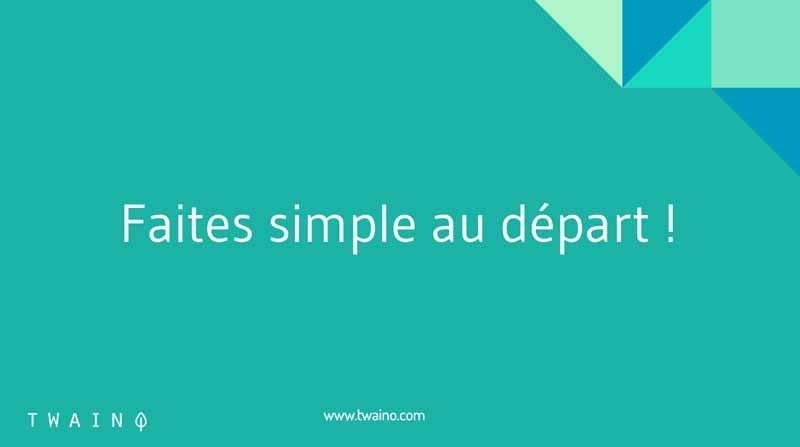
For a business to survive and grow, it must be able tocontinually make sales. Which is notsimple, especially when the business has just been launched.
For this, a good marketing strategy is essential in order to quickly generate sales and stand out from the competition. On this subject, there are several marketing tools and methods, one of which ismore effective is the sales funnel.
In addition to generating lots of sales or conversions when well designed and used effectively, this approach makes it possible to monitor the entire sales process.
Which allows, thanks to powerful analysis tools, todetect levels where there are lead leaks and provide solutionseffective.
In addition, the sales funnelmustbe constantly improved and refined, in order to follow changes in customer needs and demand.
See you soon for another article!
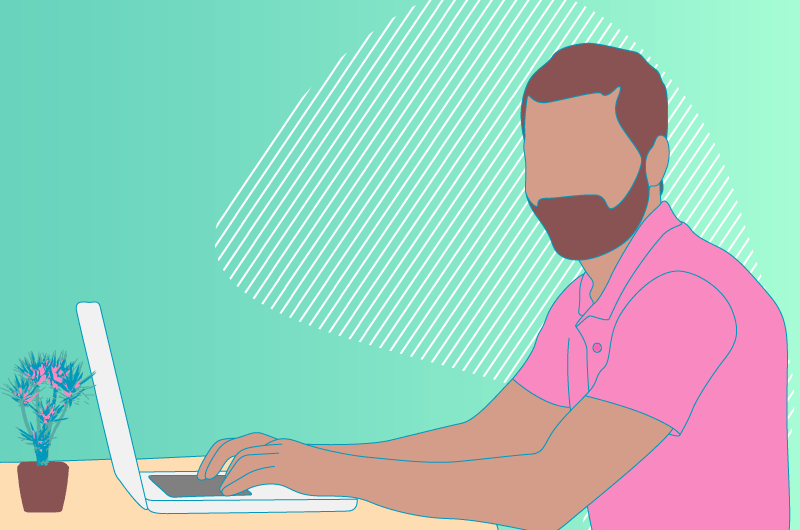

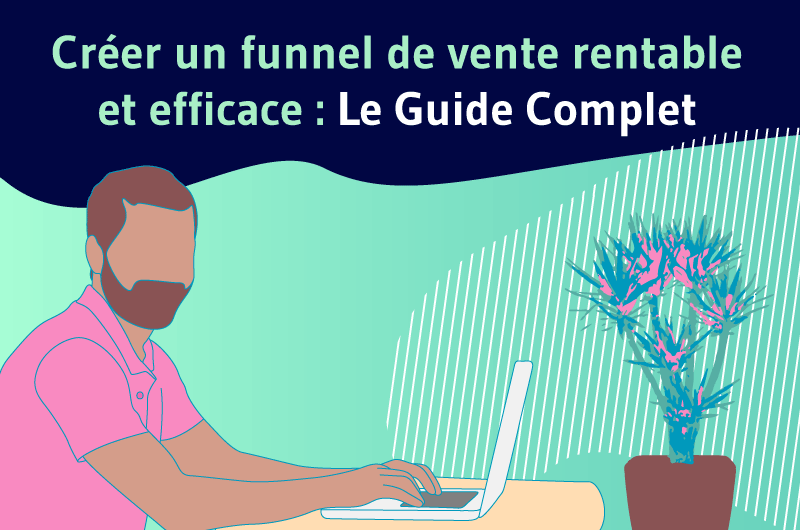


thanks
You are welcome 🙂